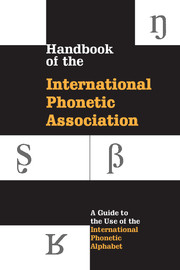 Handbook of the International Phonetic Association
Handbook of the International Phonetic Association Published online by Cambridge University Press: 06 November 2023
The Handbook of the International Phonetic Association is a resource containing concise information on the International Phonetic Alphabet and guidance on how to use it – a kind of ‘user’s manual’. It replaces the Principles of the International Phonetic Association, which has been out of print for some time and which had not been revised since 1949. But although the Handbook replaces some of the functions of the old Principles, it is a completely new work with wider objectives.
The old Principles contained a short tutorial on phonetic description, examples of the use of phonetic symbols, and a large number of ‘specimens’ consisting of very brief comments on the phonetics of a language and a transcription of the ‘North Wind and the Sun’ text translated into the language. Additionally, there was some information about the Association, and, printed on the inside covers, a brief history of it.
The new Handbook broadly speaking retains these components. It is divided into three parts: part 1 contains an introduction to phonetic description and exemplification of the use of the symbols; part 2 consists of ‘Illustrations’ of the use of the International Phonetic Alphabet for different languages (these Illustrations are ones which have appeared in the Journal of the International Phonetic Association since 1989); and part 3 contains appendices with a variety of reference material.
Beyond the basic similarity of structure, the Handbook is very different from the old Principles. Most superficially, perhaps, it reflects the changes which have been made in that most tangible and widely known product of the Association’s work, the IPA Chart. Discussion and exemplification is based on the most recent (1996) edition of the chart. More substantively, the Handbook acknowledges the fact that over the past half century the advance of techniques for acoustic analysis means that many readers will be familiar with, and quite possibly working with, speech as an acoustic signal. This means it now seems appropriate to use an acoustic display such as a spectrogram not only as a way of presenting one facet of speech, but also to discuss problems which arise in the relation between a segmentally based system of notation and the physical speech event. The Handbook will also contain practical information to do with the use of the IPA on computers, such as the computer codes for phonetic symbols.
To save this book to your Kindle, first ensure [email protected] is added to your Approved Personal Document E-mail List under your Personal Document Settings on the Manage Your Content and Devices page of your Amazon account. Then enter the ‘name’ part of your Kindle email address below. Find out more about saving to your Kindle.
Note you can select to save to either the @free.kindle.com or @kindle.com variations. ‘@free.kindle.com’ emails are free but can only be saved to your device when it is connected to wi-fi. ‘@kindle.com’ emails can be delivered even when you are not connected to wi-fi, but note that service fees apply.
Find out more about the Kindle Personal Document Service.
To save content items to your account, please confirm that you agree to abide by our usage policies. If this is the first time you use this feature, you will be asked to authorise Cambridge Core to connect with your account. Find out more about saving content to Dropbox.
To save content items to your account, please confirm that you agree to abide by our usage policies. If this is the first time you use this feature, you will be asked to authorise Cambridge Core to connect with your account. Find out more about saving content to Google Drive.